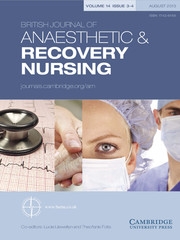When I was trying to decide what to focus my editorial on I came up with a number of different ideas, but found it hard to choose one in particular. Each of these ideas certainly merited comment; however the overarching theme among them was that they all related to ensuring patient safety. This was a recurrent theme that was also evident from the many varied sessions on offer at the recent BARNA conference. I was certainly spoilt for choice when it came to choosing which sessions to listen to, but again they were all aimed at ensuring anaesthetic and recovery nurses deliver safe care to patients.
Patient safety is a regularly discussed topic, but how can we ensure that we deliver care that is safe? One way is through education and this can be achieved through a number of different ways. In the current climate where funding for the education of healthcare staff is being reduced, we need to get creative in the way that we can access education. This can range from sharing information gained through reading an article with your colleagues, to accessing resources available to you as a result of being a BARNA member. Included in this issue of the BJARN is information related to cell salvage and the importance of ensuring that autologous blood from cell salvage is labelled to ensure that it is given to the right patient.
Another way in which patient safety can be ensured is by making sure that our practice is based on evidence and not ritual. Just because it has always been done that way, does not mean that it is the right way to do it. By using research to provide a basis for our practice we can give rationale for our actions. It can be difficult to decide which research to base our actions on though, due to the variations in reliability and validity. This task is made harder when there is a lack of current research within the chosen field you are interested in, which is often the case in relation to perioperative practice. At the BARNA conference there were a number of sessions which were based on research that had been carried out and the results used to inform practice.
One of these was the session by Deborah Dawson, Consultant Nurse in Critical Care at St George's Hospital, London. Her session explored how research has been used to guide treatments to reduce mortality and complications associated with high-risk surgery, in particular through goal directed therapy. In addition to this Deborah explained how goal directed therapy had been introduced within her clinical error and how its efficacy had been evaluated through research.
Another session at conference that demonstrated how evidence can be used to influence practice was that presented by Joni Brady, Pain Management Nurse from Inova Alexandria Hospital, USA. Joni described how nursing staff within her hospital undertook a nurse-led evidence-based practice implementation project for obstructive sleep apnoea patients within the perianaesthetic environment.
Both of these sessions were very informative and demonstrated that as nurses we can either be involved in research projects, and even lead on research projects. As an association, BARNA is committed to ensuring that our members are kept abreast of current advances in practice, so that we can utilise available evidence to base our practice on. One way in which we aim to do this is with our national audit. This year our focus is on airway management and within this issue is an article by Sarah Dawkins providing the background to this audit. The results of this audit will not only be presented in the next issue of the journal, but will also be presented at our next conference, to be held again in the Queen Anne building at the University of Greenwich, London on 27 June 2014.
Another way in which knowledge can be shared is through your contributing to the journal. This can be something as simple as sharing information about your unit and telling us what makes it special. Or if you have been involved in an audit within your workplace, writing an article that shares your findings and any changes that have evolved from this. Information about how you can write for the journal and further suggestions for ideas as to what you can write about can be found on the BARNA website. Theo and myself are always keen to hear from you, and if you have an idea but are unsure of how to get started then please get in touch. I was one given a piece of advice about writing articles ‘it is often difficult to get started, but once you begin it is often hard to stop’. So why not give it a try and see where the writing takes you.


